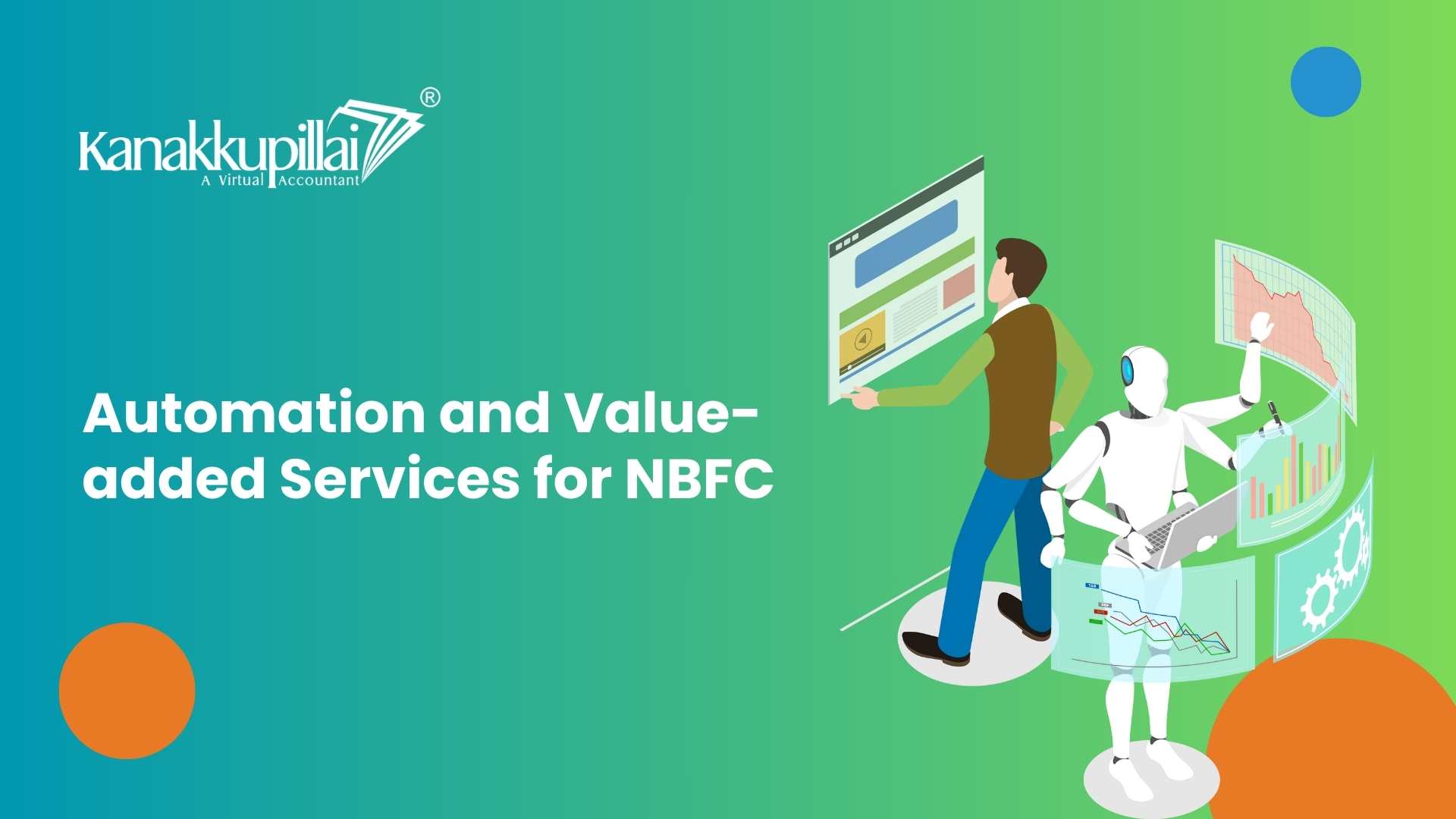![]()
By seamlessly integrating automation and value-added services, NBFCs can offer swifter, tailor-made solutions, ensuring their relevance and competitiveness in the evolving financial realm. Let’s delve deeper into the intricate dynamics of automation and value-added services for NBFCs.
What Does Automation Mean?
Automation encompasses using technology to perform tasks requiring minimal or no human intervention. This encompasses diverse realms such as business process automation (BPA), IT automation, network automation, system integration automation, industrial robotics, and consumer applications like home automation.
Automation involves harnessing technology to produce goods and services while minimising human involvement efficiently. Formerly manual tasks are now executed with heightened productivity, reliability, and speed due to automation techniques, technologies, and processes. Industries ranging from manufacturing, transportation, utilities, and defence to facilities management and, more recently, information technology have all embraced automation to varying degrees.
How Does It Contribute to NBFC Advancement?
Automation-driven optimisation initiatives are pivotal in enhancing NBFCs’ client relationships. Amidst stringent regulations that have escalated borrowing costs, automation helps NBFCs narrow their focus on specific markets and allocate resources wisely for tailored offerings. The goal is to adapt to evolving market dynamics while maintaining a competitive edge.
Modern NBFCs embrace advanced technologies to establish collaborative ecosystems spanning lead generation, client onboarding, underwriting, credit/loan disbursal, and collections. Process automation is ushering in an unprecedented level of operational agility. Machine learning (ML), Artificial intelligence (AI), and big data enable lenders to glean nuanced consumer insights and develop alternative credit assessment models.
Automation in NBFCs is ushering in novel roles:
Personalised customer experiences have always been a priority for NBFCs. Automation elevates this commitment by debunking the ‘one size fits all’ approach to customer evaluation and credit policies. Employing technology, a tailored credit evaluation approach offers current and potential clients curated experiences. This inadvertently diversifies the customer base through astute market segmentation.
Data monetisation is crucial for NBFC resilience against disruption. Analysed data sheds light on consumption patterns. When translated into intelligent tools, it acts as an aide to human decision-makers, expediting accurate decisions and system implementations, thereby boosting NBFC profitability.
Addressing cyberattacks and identity theft concerns has been an ongoing challenge for NBFCs. Innovative technology assuages these concerns, building customer trust in automated processes over manual ones.
In India, Aadhaar-based KYC spearheads digitisation by anchoring digital footprints with biometrics. Recent government initiatives like Jan Dhan Yojana, Aadhaar, and UPI have provided numerous NBFCs with a robust foundation. This empowers them to cater to nationwide demands, proving invaluable during the pandemic-induced constraints, staff shortages, and disrupted supply chains.
Enhancing Value with Supplementary Services
Value-added services encompass supplementary features a company provides alongside its core products or services. While marketing and delivering a specific offering, businesses can enhance their propositions through various means, offering customers added benefits for their investment. By improving the original offering, companies can boost revenue, attract new customers, and broaden their reach. These services include recognising consumer needs and providing practical solutions to create value-additions.
Value-added services are often extended to customers at no extra cost. Providing complimentary goods and support can elevate customer experience and satisfaction. Examples of resources that contribute additional value before and after purchase include:
- Free product samples
- Complimentary refreshments
- Upscale waiting areas
- Product demonstrations
- Membership discounts
- Convenient carry-out services
- No-cost delivery options
- Expressing gratitude through personalised notes
Benefits of Value-Added Services
Incorporating value-added services aligns with a business’s profitability and mission fulfilment objectives. By offering these supplementary offerings, companies can reap several advantages, including:
Customer Attraction: Elevating products and services with thoughtful enhancements appeals to customers who seek exceptional quality and considerate experiences. The addition of value draws in new clients and amplifies overall revenue.
Distinctiveness in the Market: Customers are inundated with choices in saturated markets. Setting your business apart and capturing attention can be achieved through unique value-added features, setting you apart from competitors.
Fostering Customer Loyalty: Consistently delivering value nurtures brand loyalty over time. Loyalty programs and membership perks enhance customer retention rates, ensuring a committed clientele seeking added value.
Complimentary Benefits: Value-added services often include complimentary goods or services, supplementing regular purchases. Customers benefit from receiving extra value with their transactions.
Robust Return on Investment: Customers expect enduring benefits when investing in products or services. Value-added offerings provide customers with a return that surpasses their initial investment.
Building Trusting Relationships: Engaging in value-added services and loyalty programs enables customers to establish trust and forge lasting relationships with providers. A trustworthy brand or business enhances the customer experience and fosters enduring partnerships.
The Significance of Utilizing Automated and Value-Added Services
The advantages of incorporating automation and value-added services encompass:
Optimal Customer Experience: Automation is most prominently employed in the banking and non-banking sectors for customer service. Many of you have firsthand experience with this. Numerous businesses feature chatbots on their websites. These chatbots engage visitors, offering solutions or directing them appropriately based on their responses to pre-programmed inquiries.
Enhanced operational efficiency and rapid customer service are achieved in banking and NBFCs (Non-Banking Financial Companies) by integrating automation and value-added services. This leads to expedited processes for tasks like account opening and loan disbursement, which increases overall client satisfaction.
Tailored Solutions: Customers benefiting from AI-driven solutions receive personalised answers aligned with their specific requirements. For instance, your financial plan or loan eligibility might vary based on your needs and credit score. Banks utilise AI systems to analyse consumer data, thereby gaining insights to provide loans with varying interest rates and cross-selling products tailored to the user profile.
Augmented Efficiency: Technology’s aid significantly bolsters financial institutions’ efficiency. As processes become swifter, NBFCs experience increased staff and procedural productivity. This, in turn, benefits customers by reducing turnaround times and enhancing service provider efficiency.
Cost Savings: Integrating automation and value-added services in the banking sector leads to cost savings and heightened profitability for businesses. These benefits become apparent through diminished reliance on human resources, heightened productivity, error reduction, and decreased defaults. Consumers reap rewards as service fees fall over time, lowering costs.
Automated Debt Recovery: Using AI-driven mechanical debt recovery systems, lenders can streamline debt collection. These systems facilitate automatic reminders, saving time and resources. By accessing comprehensive client borrowing histories, lenders can mitigate bad debts. Customers also benefit from timely reminders, reducing the likelihood of missed payments and associated late fees.
Effortless Loan Access: Customers of NBFCs offering value-added services gain swift access to loans whenever required. This nurtures a robust customer-NBFC relationship, positioning the NBFC as the go-to service provider for customers.
Financial Planning Tool: Equipping clients with tools and resources for managing spending, saving, and investments empowers them to make informed decisions.
Exclusive Offers Access: Establishing partnerships with other businesses to grant customers exclusive discounts or perks amplifies the value of NBFC services.
Revolutionising the NBFC Landscape: Emerging Technologies at the Forefront
- Artificial Intelligence (AI) & Machine Learning (ML)
AI and ML have emerged as transformative forces within the NBFC sector, orchestrating process automation and elevating decision-making prowess. These technologies are rewriting the operational playbook for NBFCs by furnishing insights and analyses that sharpen decision-making acumen, cut costs, and amplify customer experiences. According to a PwC report, AI and ML will inject $1 trillion into the Indian economy by 2035. In NBFCs, AI and ML are harnessed for diverse applications, including credit assessment, fraud identification, client profiling, and risk management. Their capability to swiftly and accurately process vast data volumes propels’ NBFCs into a more competitive stance within the market.
- Blockchain
The ascent of blockchain technology is another pivotal stride taken by NBFCs. This innovation has virtues like transparency, security, and operational efficiency. NBFCs are meticulously exploring it for its potential to revolutionise the landscape of financial services delivery. As per NASSCOM’s insights, the Indian blockchain market anticipates a growth trajectory of 58% CAGR by 2025. Blockchain’s applications within NBFCs span varied domains such as loan disbursement, KYC verification, and asset management.
- Robotic Process Automation (RPA)
Robotic Process Automation (RPA) and a paradigm shift within the NBFC sector have been drivers influencing the change. This technology enables the automation of basic tasks, including origination, servicing and collections, thus enabling cost reduction, improvement of operational efficiencies and excellent customer journeys. These forecasts from Gartner predict a growing RPA market on the global platform with a compounded annual growth rate of 19.5% by 2027. Using RPA, the NBFCs are empowered to atomise routine tasks, minimize errors, and encourage employees to adopt high-value employment engagements.
- Internet of Things (IoT)
The Internet of Things (IoT) has triggered transformative shifts across diverse sectors, including the financial realm, with NBFCs as beneficiaries. IoT’s prowess in the NBFC realm lies in its capability to provide real-time insights into customer behaviour, spanning spending patterns and creditworthiness. This dynamic data forms the bedrock for furnishing tailor-made products and services, translating to amplified customer satisfaction and loyalty. IoT’s potential finds resonance in NBFCs’ exploration of IoT devices to usher in innovative financial services such as usage-based insurance.
- Cloud Computing
Cloud computing is scripting a transformation within the NBFC sector, furnishing the ability to store and dissect voluminous data sets and enhancing decision-making acumen and operational efficacy. IDC’s predictions anticipate the Indian public cloud services market will scale new heights with a 22.2% CAGR by 2025. Cloud computing enables NBFCs to harness the potential of big data analytics, facilitating insights into customer behaviour, enhancing risk management, and offering bespoke financial services.
- Biometrics
The impact provided by the biometric technologies in the NBFC landscape is significant, with a layer of security and personalisation in financial services. Authentication and verification are achieved through biometrics such as facial recognition, fingerprint scanning and voice identification in a bid to avoid the compromising of vital data and fraud. According to MarketsandMarkets, the global biometrics market is set to witness a considerable 15.6% CAGR by 2026. Biometrics also makes it possible for an individual customer to have a smooth and personalized financial experience.




